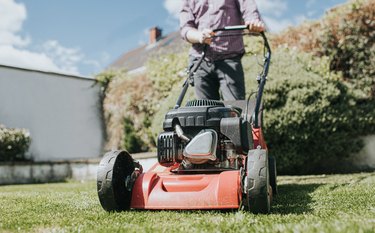
The day dawned sunny and bright. No rain was in the air, and it seemed a perfect time to drag out the lawnmower and give that long grass a cut. But the sun began to creep higher in the sky, turning the day into a scorcher. You prevailed, but a few days later the grass turned brown after mowing and looked like it was dying. Before calling in a lawn care expert to diagnose the problem, check your mower, as it may be the cause of your lawn becoming brown after mowing.
Causes of Brown Grass Tips
Video of the Day
Like any cutting instrument, the blades of your mower need to be sharpened. Cutting your grass with dull mower blades leaves the grass tips rough, causing torn edges and an uneven cut to the lawn. The bruising to the blades of grass is an invitation for stress and disease. Hot, dry and intensely sunny days dry out the moisture in the lawn. Letting the grass get too long between cuttings is also damaging to the grass blades.
Video of the Day
The one-third rule of mowing should keep your grass green: Never cut more than one-third of the grass blade's length. Too short a cut causes browning, so you'll need to raise the height of the blades. And, don't cut when the air is very dry or during drought conditions. Mowing when rain or water is sparse removes any moisture that has been stored in the grass. The same rule holds true if frost has moved in. Don't mow until the grass has dried.
Other Causes for Lawn to Brown After Mowing
You've abided by the rules of good mowing and still your grass is turning brown after being mowed. One of the reasons may be the detritus left behind. Grass needs sun and air to flourish. Leaving dead grass on top of a newly mowed lawn is like covering the lawn with a blanket, especially if it's been a long time between cuttings. Put a grass catcher behind your mower and remove the cut grass as you mow.
If grass doesn't receive light for several days, it starts to deteriorate. Keep the grass free from falling autumn leaves. After mowing, give the grass a good watering to refresh the soil and the newly trimmed blades of grass. Don't water in the evening. Morning is best, before the sun bakes the grass and absorbs all the moisture.
Brown Grass Tips and Disease
One of the effects of cutting grass with dull blades, in addition to the ragged edges, is that the grass is exposed to disease. Tears and bruising are invitations to fungus. To guard against fungus infecting the lawn, mow frequently but not too short. Don't overwater the lawn and aerate it at least twice a year. And, don't over-fertilize.
If the brown spots occur close to a large tree, investigate whether the tree is preventing sun from reaching the lawn. If so, prune the tree to allow light to pass through. Test the soil's pH balance and determine if it's correct for your hardiness zone.